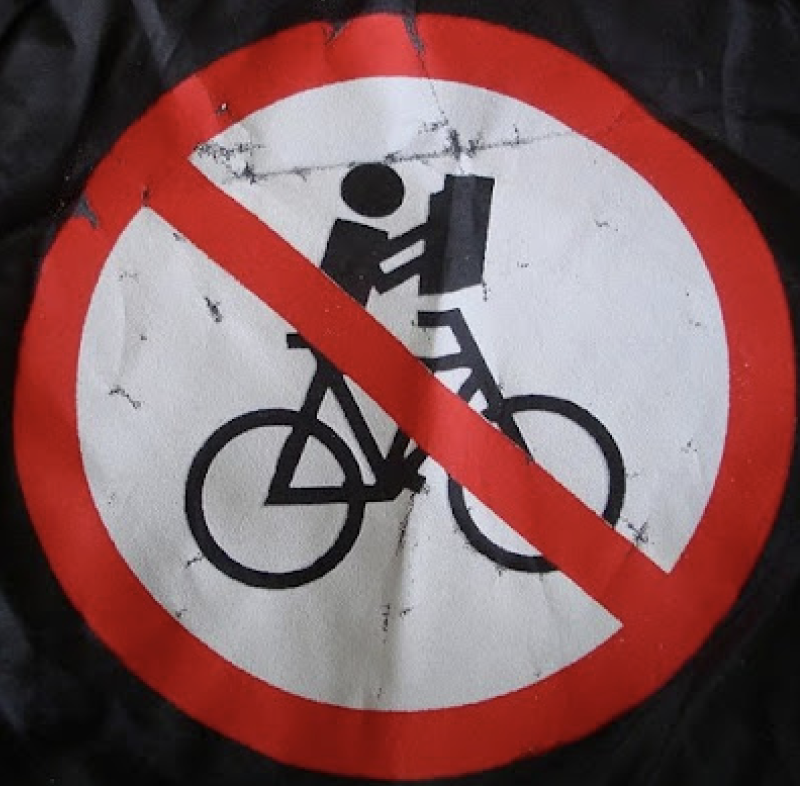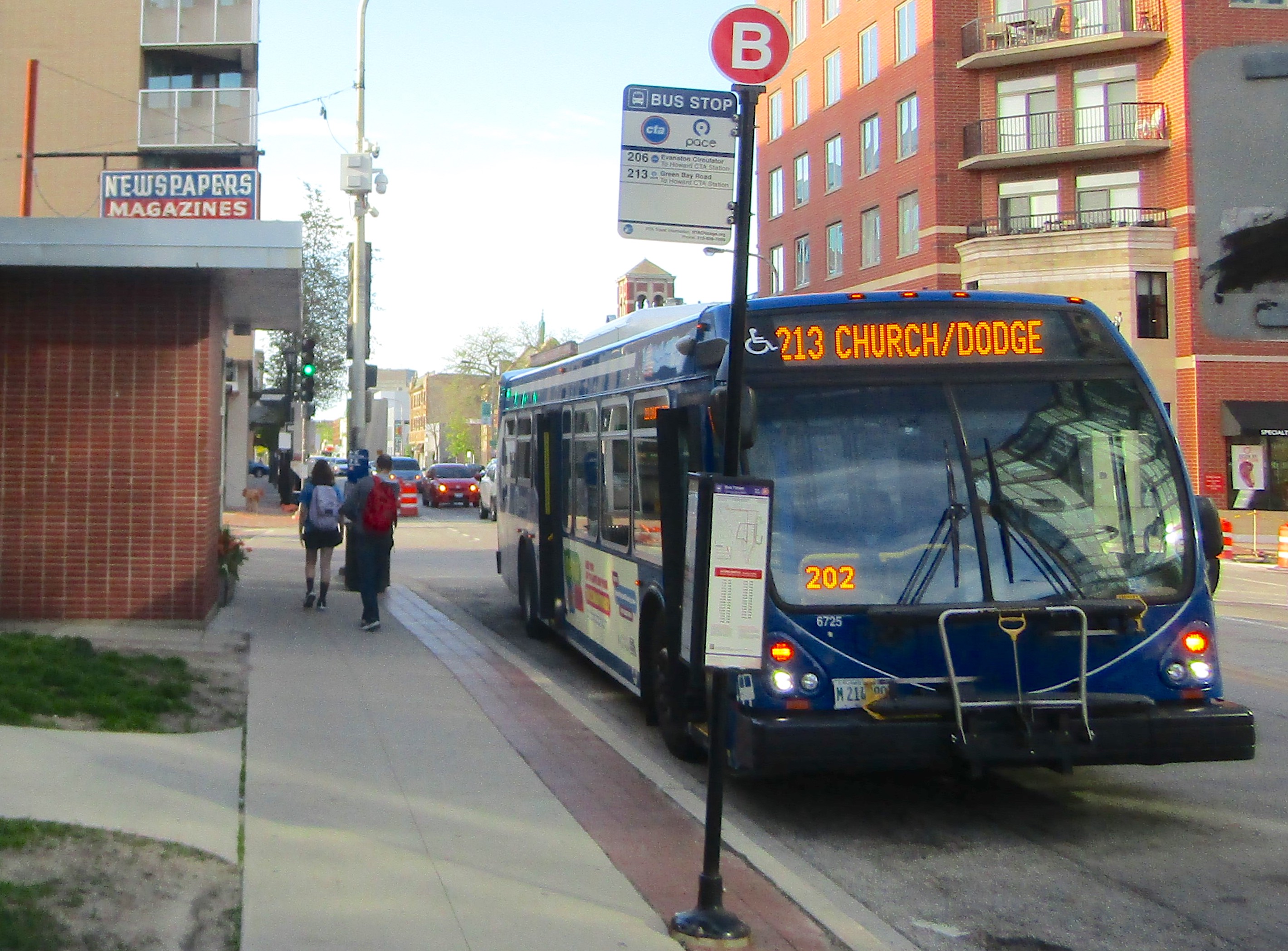Confirmed: Current CTA unreliability is caused by staffing shortages. How do we fix that?
2:42 PM CDT on November 5, 2021

Two out of the three buses clustered at Foster and Clark in Andersonville during a recent rush hour. Photo: John Greenfield
Chicago officials have boasted that the CTA is the only major U.S. transit system that hasn't reduced service during the COVID-19 pandemic – on paper, at least. But Streetsblog has heard many reports of poor reliability and unusually long headways on bus and 'L' routes in recent months, as well as inaccurate arrival times on the Bus Tracker and Train Tracker apps and digital displays at stops. For example, here are some responses from readers to our Twitter query on the subject.
- "Waited 40+ minutes for a 56 northbound [Milwaukee] bus at Milwaukee and California on a Saturday morning earlier this month. Took almost two hours to get from West Town to Portage Park."
- "Imagine 5 different widgets that tell you train/bus arrival times, each one says something different, when your train is 8 minutes away… Suddenly it’s 17 mins! I've waited literally 40 mins for the 157 [Streeterville/Taylor], watching the arrival times come and go. Good job on encouraging more driving CTA."
- "On the 73 [Armitage bus], there will be weeks where a very specific run will simply be missing. Eg., instead of having 6 and 6:20 p.m. buses, it will be 6 and 6:40 p.m. Regular delays on the Red Line too – small phantom cuts, where on a daily basis a train that should run every 6-7 minutes is every 8-9."
- "I took the 'L' every Sunday in August and September and the weekend schedule was literally the worst. It took about an hour to get from Ravenswood to Clark/Division. The weekend of Lollapalooza was so bad, it took two hours and I had to walk to find a bus since the 'L' was so packed!"
- "I often find that the #50 [Damen] bus is more than 25 minutes away and sometimes no buses will show up on the tracker. Especially on weekends! I've found the same thing on weekends with the 65 [Grand] and 66 [Chicago Avenue] buses too.
Blue Line S/B during a.m. rush frequently has 10 min headways. If we want people back on transit, reducing service won’t do it. It’s fun standing around on the platform absorbing all the noise/exhaust of lone motorist commuters given 10 lanes. Also, fix escalator at Clark/Lake. pic.twitter.com/GdT78lUAca
— unmikely (@Unmikely) October 19, 2021
We got dozens more responses along those lines. I'd heard rumors that the delayed and missing runs were due to staffing shortages. But the issue was hammered home to me one evening when I was biking south on Clark Street in Andersonville when I encountered a uniformed CTA employee standing in the street at Foster Avenue, asking southbound road users to wait at a green so that a northbound articulated bus driver could make a westbound left turn on Foster. Meanwhile, two other northbound buses were stopped on Clark south of the intersection. It wasn't clear exactly what was causing this chaotic situation, but the worker directing traffic told me short-staffing was a factor.

Keith Hill, president of the Amalgamated Transit Union Local 241, backed up this explanation for the current CTA weirdness. (He said the employee in Andersonville may have been trying to equalize the space between bus runs.) "The CTA's hiring sucks right now," he said. "They're not replacing people lost to retirement or attrition, or those on extended sick leave." He said there are normally five or six employees retiring a month, but now it's more like 30 to 40.
Meanwhile, Hill said, only two or three people are coming through training a month right now, while there used to be 30 or 40. And that's after six months during the depths of the pandemic when the CTA wasn't hiring at all, he stated.
So why is the CTA lagging so far behind in hiring? "I don't know," Hill replied. "The more we complain about it, the less response we get from management. But the one place where they shouldn't be cutting corners to save money is bus operations, because the one thing they should be committed to is moving the city."
CTA spokesperson Brian Steele provided a long email statement addressing the reliability and staffing issues. "Throughout the pandemic, the CTA has worked very hard to provide as much service as possible. However, like every U.S. transit agency, the pandemic has impacted our workforce, including employee scheduling and availability."
"CTA employees are dedicated men and women who bravely and selflessly worked through the worst of the pandemic, to provide the transit service so many people relied on," Steele added. "But like others providing essential services, many of our employees were impacted by COVID-19. When an employee must call off of work due to illness, self-quarantining, childcare needs or other personal matters, it can temporarily affect the schedule of buses and trains. When an unplanned absence like that occurs, we work to put operators and staff in place to minimize the impact on service. But even one missed train run can create a gap in service, and thus a longer wait time for customers at a station."
Steele said the CTA has measures in place to address routine absences such as Extra Boards of additional employees at bus garages and rail terminals who fill in when a scheduled employee calls off sick or can’t make a shift. "But the extraordinary challenges presented by the pandemic are pushing the limits of even industry best practices for addressing these kinds of workforce impacts."
He said that, in addition to keeping employees healthy, preventing absences was a main reason the CTA created an in-house agency vaccination program in Spring 2021, when vaccines were becoming widely available, and more recently implemented a mandatory vaccination requirement (which the union objected to.) "Both efforts have helped the CTA stabilize its workforce and reduce absenteeism caused by COVID-19," Steele said.

Contrary to what Hill stated, Steele said the CTA is actively recruiting workers to fill existing vacant positions. "To that end, the CTA is strongly marketing employment opportunities, hosting virtual and in-person job fairs (including one last week held in conjunction with ATU Local 241 and 308). We’re also advertising the benefits of CTA employment, including good pay, excellent benefits and paid training for new recruits. While this has attracted interested job-seekers, it does take time to fully train new employees on the safe operations of our trains and buses."
"Though we didn’t cut service, we occasionally have been unable to meet scheduled service levels, due to temporary staffing shortages," Steele concluded. "Those trips that we’ve been unable to put out were not a planning decision – they were a reflection of the realities of the pandemic. We did not pursue scheduled service cuts, as cuts would have a much more drastic impact on customers than the slightly longer-than-normal waits some customers have experienced."
Streetsblog Chicago shared Steele's statement with the Active Transportation Alliance. Advocacy manager Julia Gerasimenko noted that transit workers have contracted COVID-19 at higher rates than the general public and many have passed away as a result. "Hazard pay is one step transit agencies can implement to better support transit workers and help recruit new workers to overcome the undeniable impacts on service the worker shortage has caused. Transit workers know what they need best and how to recruit more workers to keep Chicagoans moving during this unprecedented time."
Regarding impacts on service, Gerasimenko said, "CTA should focus on providing updates and communicating to riders in a timely manner, particularly bus riders who rely on the Bus Tracker for updates rather than announcements at rail stations. More resources should be put towards keeping the Bus Tracker as accurate as possible to ensure riders are not left in the dark."
So we've accurately diagnosed the cause of current CTA unreliability. Now we need to hold the agency accountable for keeping its promise to "actively recruit workers to fill existing vacant positions."
In addition to editing Streetsblog Chicago, John writes about transportation and other topics for additional local publications. A Chicagoan since 1989, he enjoys exploring the city on foot, bike, bus, and 'L' train.
Stay in touch
Sign up for our free newsletter
More from Streetsblog Chicago
Elevated Chicago’s new leader on how to build more support for equitable transit-oriented development
Recently announced as executive director Juan Sebastian Arias also shared his POV on Mayor Johnson's Cut the Tape initiative to speed up the development approval process
Since COVID, Pace ridership has fared better on major corridors and in north, northwest suburbs than in south, west ‘burbs
The suburban bus system's top five busiest routes largely maintained their ridership rankings.
Due to incredible support from readers like you, we’ve surpassed our 2023-24 fundraising goal
Once again, the generosity of walk/bike/transit boosters is fueling our reporting and advocacy.




